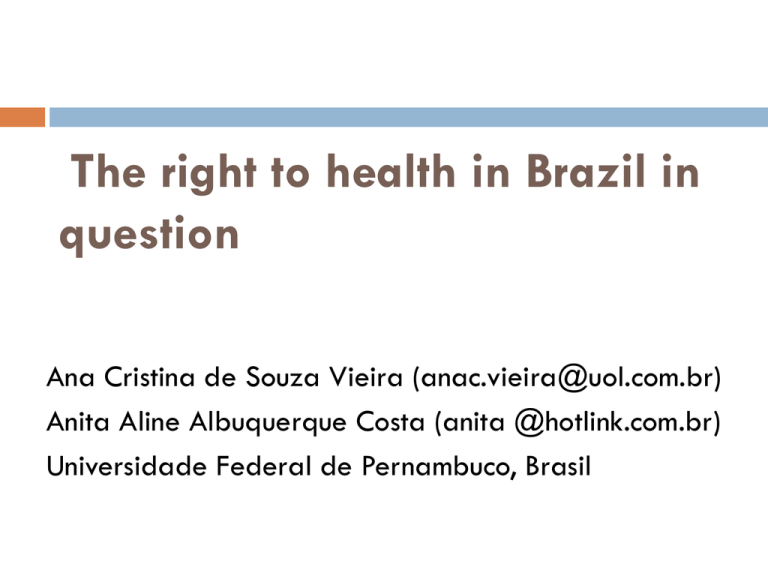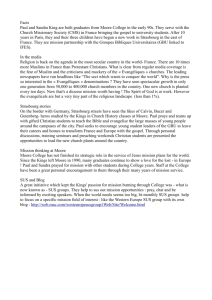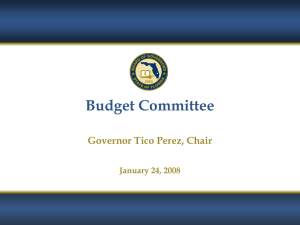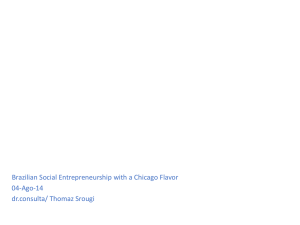health policy facing social inequalities and poverty in brazil
advertisement

The right to health in Brazil in question Ana Cristina de Souza Vieira (anac.vieira@uol.com.br) Anita Aline Albuquerque Costa (anita @hotlink.com.br) Universidade Federal de Pernambuco, Brasil People living with an income until US$35/month: 8,5% of population Brazilian inequality Brazil is the 11st country in inequality in the world There is a small decreasing of inequality measured by the Gini index in the last ten years: between 1999 and 2010 dropped from 0,599 to 0,539 Since 1990 the Brazilians citizens have the constitutional right to comprehensive health care, as a State responsibility, without payment Health care in Brazil - before 1988 It was headed by private medical groups guided by a market logic, that sold services to the governments The public health care model was based on hospitals privileging a curative perspective, restricted to people in formal employments. Primary health care was limited to epidemics Social movement at the end of seventies – questioning dictatorship, and asking for democracy, discussed the right to health Movement of Sanitary Reform Intended to break the logic of private health care model, to establish universal access to health care – changing from curative to preventive care. The concept of health was redefined from the lack of disease to an understanding that health is the result of social determinants, such as work, leisure, housing, food, education, among others 1988 – A new health policy – SUS (Sistema Único de Saúde) – Public National System of Health SUS - a public health system Decentralization – local governments are responsible for implementing health services Health promotion, prevention, treatment and rehabilitation. Social participation, through health conferences and health councils with civil society SUS had a strong resistance, especially by the private health sector: hospitals, private health plans and insurance Neo liberal paradigm proposed the cut of public services, opening spaces to private health sector Public health spending Lower compared to developed and developing countries including our neighbors in Latin America. Brazil: 3.45 of the Gross Domestic Product (GDP), Argentina 5.1%, Spain, 5.4%, and France, 7.2% (Health Organization WHO, 2007:142). 2008: small increase in public spending in health services as a percentage of GDP – 3.60 These expenses had an irregular behavior, in terms of the amount specifically allocated to financing public health actions and services. Importance of SUS 68% of all hospitalizations and 73% of the out patient services in health area are provided by National Public Health System. So, SUS is responsible for over two thirds of the health care in the country and shows the scope of its network caring for the health of the population of the country(IPEA, 2007: 131). Improvement in the indicators for child mortality and life expectancy at birth - at Northeast, the reduction in child mortality between 1996 and 2008 was from 60,4 to 21,7 deaths of children under one year of age per one thousand live births. Health care challenges: restrictions to universalization SUS faces some problems: limits in accessing health services and adequate health care difficulties in labor relations lack of human resources lack of financing: while heath sector uses 3.6 of GDP, the payment of public debt kepts more than 40% Focus of Health Family Strategy on extreme poverty – community based services Partnership with private sector – questioning the right to health Privatization of public services, an increasing of non-governmental participation in providing services - use of social organizations to manage the public system Pernambuco: 3 new hospital and 14 emergency services , management by private sector Restrictions to people assistance – some can not be seen by the health workers because the health problem is not considered urgent, although there is not another health unit to help











